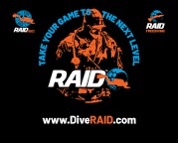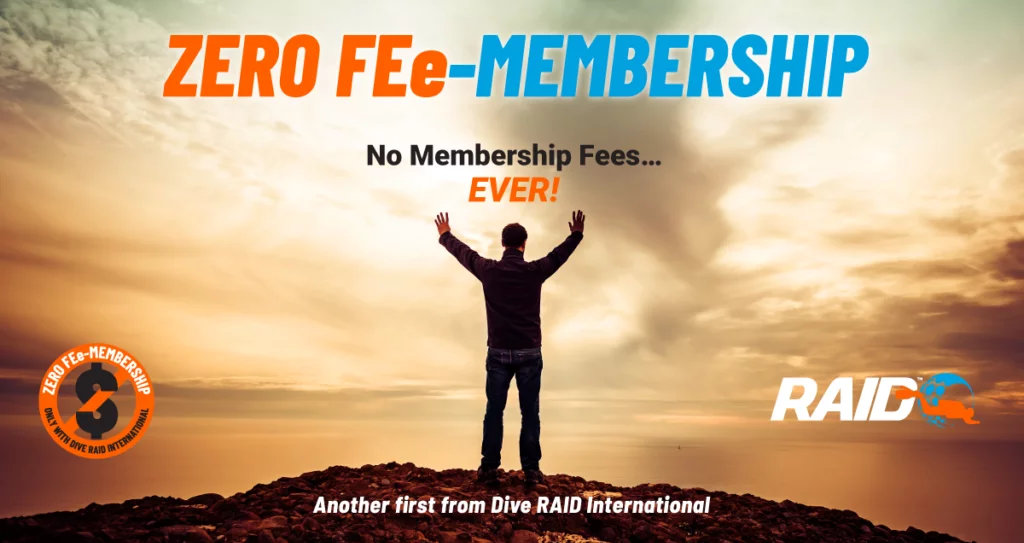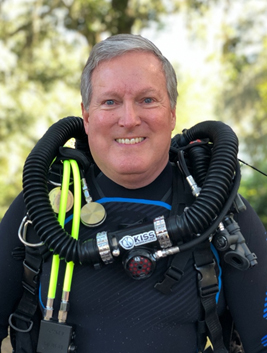Click here for all the info: Independent Diver – Course Release

Click here for all the info: Independent Diver – Course Release


RAID ZERO FEe-MEMBERSHIP – UPDATE
We had planned for a healthy response, but even so, we are in shock. We have been inundated with emails, phone calls, texts and instant messages of every flavour. Mostly, from our members saying thank you for making this work, from instructors and dive centres asking, “how do we crossover to RAID?” and from others asking how on earth is this possible?
Let’s get a few things sorted, and let’s start with the basics.
For most of us, annual subscriptions have always been a drain on cash-flow at a difficult time of year. So, we have worked out a modern business model that solves this.
The overview is simple: if we make it easier for our members to stay in business, their business grows. The result, increased revenue for them and for RAID. This makes Zero FEe-Membership viable for RAID, and it will not affect the level of service we provide or the depth of that service.
We believe subscriptions have hindered the industry over the past several years. We are working to grow it, hence the need for all pro’s to certify five (5) divers (minimum) to maintain Zero FEe-Membership status arch year. And dive centres still pay for course credits and associated cost of doing business. We have not made any of those costs ‘free.’ However, as always, those trade costs are competitive and realistic for dive centres… but not Free!
A lot of strategic planning went in this marketing campaign, it’s been years is this RAID internal mixer. We cannot share the business model we’ve developed to make this work – our competition would love us to do that.
Dive Raid International has worked from day one to be a bit different by design. There are plenty of resources available highlighting these, the fact is, our fixed costs are less than our major competitors making this for us.
Dive RAID International is supported RAID Regional Offices, these guys eat, sleep and eat diving and are there regional business needs… for some of them, RAID is all they do day-to-day. These twenty (20) offices and staff make an efficient and effective, they’re potentially near you now, speaking your language and available.
And one final thing to consider: The management team’s mantra here at RAID is to be nimble and agile. As such, we will always strive to lead rather than follow. Zero FEe-Membership is another example of that difference. Dive RAID International is member-centric and we have worked hard to make Zero FEe-Membership happen for us all, we all need it. And we know it confuses some and frustrates those who are locked into expensive annual subscriptions. But we believe you will support us and this ground-breaking initiative because RAID is your agency.
CONTACT info@diveraiduk.com or your local RAID Regional Office for full details and for instructions on how to remain in status for 2022 or cross your instructor membership or business over to Dive RAID International.
*To maintain active status in 2023, RAID instructors will be required to certify five (5) divers during 2022. Should this not be achieved, instructors will be required to do an online update which will detail all the changes at RAID during the past year.
RAID 2022 Updates
RAID UK Ltd will be running three update sessions at the Go Dive Show – 4th–6th March.
These will be on: 15.00 – 17.00hrs on Friday 4th and 12.00 – 14.00hrs on the 5th/6th.
These updates are important to receiving and maintaining all the relevant information and news from RAID UK and RAID International. Presenters will include Paul Toomer ( President RAID Int’l ) Steve Lewis (VP Marketing) and PJ (Training Director)
There is limited space for these closed-door pro events – the price to attend is £65 – email: info@diveraiduk.com to book your place now!
You can book and pay on the day too, but we encourage prior booking to ensure your seat.
Douglas Ebersole, MD – RAID Medical Advisor
With the current COVID-19 pandemic there have been reports of patients with low blood oxygen levels but very little in the way of symptoms. As a result, pulse oximetry has been getting a lot of press. Divers have been especially concerned after a recent report of six divers who felt they had recovered from COVID-19, but were found to have markedly abnormal CT scans of the lungs. This has led to a number of divers purchasing pulse oximeters, often with very little understanding of how they work. So, what do divers need to know about pulse oximeters?
As you likely remember from high school biology, the right side of the heart pumps oxygen-poor blood to the lungs to get oxygen. The oxygen rich blood from the lungs then returns to the left side of the heart and is pumped to the tissues of the body which extract oxygen and return the blood to the right side of the heart to start the cycle all over again.
Oxygen is carried in the blood by red blood cells containing hemoglobin, a protein which has binding sites for four oxygen molecules. While some oxygen is dissolved in the blood, this is a very small amount compared to the amount of oxygen carried by hemoglobin. Hemoglobin increases oxygen carrying capacity by over 70-fold compared to dissolved oxygen in blood alone. The percentage of hemoglobin binding sites that have bound oxygen, termed oxygen saturation, is based on the partial pressure of oxygen. Blood leaves the lungs with a partial pressure of oxygen (PO2) of about 100 mm Hg, corresponding to an oxygen saturation of about 98%. This means 98% of the hemoglobin oxygen binding sites have an oxygen molecule attached. The body’s tissues metabolize oxygen so that in the tissues the PO2 is around 40 mm Hg, corresponding to about 75% oxygen saturation. As a result hemoglobin releases oxygen molecules in the tissues and then binds carbon dioxide, the waste product of the cells, and carries it back to the lungs where the carbon dioxide is released and more oxygen bound.
Refer to the image of the oxyhemoglobin saturation curve and note that it is a sigmoid shaped curve. There is NOT a linear relationship between PO2 and oxygen saturation. At upper levels of PO2, there can be a significant drop in PO2 without much change in oxygen saturation. However, below a PO2 of about 40 mm Hg, small drops in PO2 can result in large drops in oxygen saturation.
So, for a healthy individual who has a normal, PO2, supplemental oxygen is really going to do nothing for your oxygen saturation. However, with diseases such as pneumonia where gas exchange in the lungs is compromised, PO2 can decrease to the point that there is not enough oxygen bound to hemoglobin to provide tissues the needed amount of oxygen. Oxygen saturations of < 90% are of concern and where supplemental oxygen is useful. You can measure the PO2 and oxygen saturation directly by drawing blood from an artery or you can noninvasively monitor the oxygen saturation using a device called a pulse oximeter.
A pulse oximeter is a small device that looks like a clothes pin or a chip clip. You place your finger inside of it and within seconds it will light up with your heart rate and oxygen saturation. Most healthy people should have oxygen saturation of around 95-98%. As mentioned above, values < 90% are concerning and should be relayed to your physician.
When you insert your finger into a pulse oximeter, it beams different wavelengths of light through your finger. Hemoglobin absorbs different amounts and different wavelengths of light depending on the level of oxygen it is carrying. It then displays your oxygen saturation and pulse rate. Of note, these devices work better with warmer hands than with colder hands and do not work well with dark nail polish. Usually, the index finger or third finger works best. The accuracy of professional devices used in hospitals is within two percentage points of that directly measured from a sample of blood taken from the artery.
There are many diseases that result in lower than normal oxygen levels in the blood. Some of these diseases, including COVID-19, can result in very low oxygen saturation in the body but with a paucity of symptoms, at least initially. Pulse oximetry can be very helpful here. While monitoring yourself for symptoms of cough, shortness of breath, fever, and chest pain is most important, a lower than expected oxygen saturation reading on a pulse oximeter might give you an early warning that you are decompensating and need to seek medical attention sooner as opposed to later.
Also, some people recovering from respiratory illnesses such as COVID-19 may have normal resting oxygen levels in their blood, but then have these markedly decrease with exercise. This is called exercise-induced hypoxemia and is a marker of persistent inadequacies in ventilation and gas exchange. It usually manifests at or near maximum exertion. Obviously, this could be a concern for the diver who feels well and has a normal resting oxygen saturation, but who would develop hypoxemia with scuba diving. Hence, if you are recovering from a respiratory illness such as COVID-19, your physician may recommend you have normal pulse oximetry, both at rest and with exercise, before returning to diving.
If you decide that you would like to have your own pulse oximeter, remember buyer beware. At-home pulse oximeters can vary widely in accuracy – by as much as 6% according to a 2016 study published in the South African Medical Journal. This study compared low-cost, portable fingertip oximeters with bedside monitors used in hospitals and found that fingertip pulse oximeters were reliable under normal oxygen level conditions but less reliable during low-oxygen level situations. You would think that the more the device costs, the more accurate it would be, but this is simply not necessarily the case. Before purchasing one, go to the FDA’s 510k Premarket Notification Database and search for “oximeter” LINK HERE.
Smartphone apps and wearable devices like those from Fitbit and Garmin, and rumored to be coming soon from Apple, use a slightly different technology to approximate blood-oxygen levels. Instead of measuring “transmittance” of light with a receiver on the other side of the finger, wearable devices and camera-based apps use “reflectance”, usually against the wrist, to estimate oxygen saturation. According to Dr. Philip Bickler, a professor of anesthesia and director of the Hypoxia Lab at University of California San Francisco, the current “reflectance” devices are less accurate than the standard “transmittance” oximetry. So stay tuned.

From the Aug 1st, you can renew your RAID Membership until Oct 2020. All Dive Centres should speak to their regional office to renew themselves and their teams, all Inst and Divemaster who aren’t affiliated to a Dive Centre should use the website/ Profile log in.